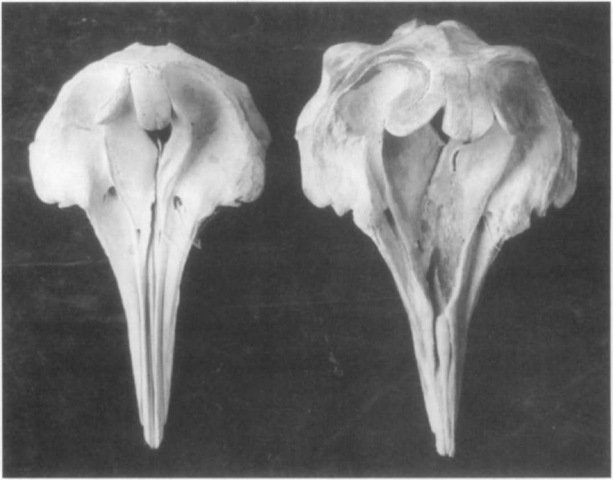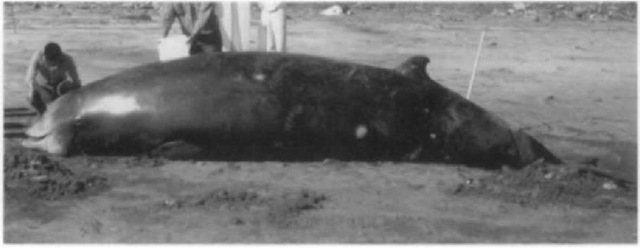The original description of Ziphius cavirostris is based on a partial cranium collected near the village of Fos, France, in 1804. In his species description, Cuvier mistakenly identified the specimen as a fossil because he thought the skull was “petrified.” The specimen actually represents part of a skull, including a densely ossified rostrum with a well-developed prenarial basin of an adult male. This basin, or cavity, on the top of the skull just anterior to the bony nares led to the trivial name of cavirostris. The densely ossified rostrum is found in adult males of Cuviers beaked whale and mesoplodont beaked whales (Fig. 1). The function of this rock-hard snout is unknown, but it has been postulated to either reinforce the skull when males fight or serve as a sound conduit. The most common English names for Z. cavirostris are Cuvier’s beaked whale and the goose-beaked whale, both of which are in wide usage.
The general body shape of Z. cavirostris is similar to other beaked whales with a rather robust, cigar-shaped body. The falcate dorsal fin is relatively small and set approximately two-thirds of the body length posterior to the rostrum. The flippers are also relatively small, narrow, and can be tucked into a slight depression or pocket along the body wall. This flipper pocket is also found in other ziphiids and is assumed to allow the flippers to be held tight against the body while swimming. As with other ziphiids, the flukes are proportionately large and, as a rule, lack the distinctive medial notch found in all other cetaceans. The head is rather blunt in profile with a small, poorly defined rostrum that grades into a gently sloping melon region. There is no significant difference in total length between sexes for Z. cavirostris, with an average adult size of 6.1 m. There are several reports of specimens that exceed 7.0 m in length, but virtually all of these appear to be either estimates of lengths or based on misidentified animals. The largest accurately measured specimen of Z. cavirostris is an adult male that measured 6.93 m from the Falkland Islands. There is one pair of throat grooves that converge, but do not meet anteriorly. Beaked whales feed primarily by suction and these grooves allow the throat region to expand as they slurp in their prey.
The pigmentation pattern for male Z. cavirostris is a dark slate gray over most of its body with a distinctively white head. This white coloration continues slightly posterior along the dorsum. This appears to be the pattern found in most mature males (Fig. 2). Adult females tend to vaiy in general color from a dark gray to a reddish-brown, with a slight lightening of the skin on the head. This is not as dramatic a contrast as in males and does not appear to extend posteriorly on the dorsal aspect of the body. Usually there are some distinctive patterns of dark pigment on the head of adult females. The eye is typically dark and there is a highly variable pair of dark crescents surrounding the eye, one anteriorly and one posteriorly. Newborns are dark black or bluish-black above and lighter below. This pigmentation pattern is very similar to that found on young beaked whales of the genus Mesoplodon and may represent the primitive pigmentation pattern for the calves of many ziphiids. Light oval patches and linear marks are quite common on the skin of Z. cavirostris, which can give an animal a mottled appearance. The oval patches on ziphiids have been attributed to scars left by lampreys or cookie-cutter sharks of the genus Isistius. Linear marks have been attributed to scars resulting from the teeth of males raking along the skin during intraspecific fighting. The only erupted teeth are the apical pair in adult males, and linear scars are most prevalent in mature males.
Figure 1 As males o/Ziphius cavirostris become sexually mature, they begin to reabsorb bone in front of the nasal passages, creating over time a distinct cavity or prenarial basin seen easily in this dorsal view (right). Adult females and immature males lack this basin (left).
As with most uncommon cetaceans, the distribution of Z. cavirostris is known primarily from strandings. This type of information may be somewhat biased, especially with regard to the abundance for a particular area. Stranding records indicate that Z. cavirostris is the most cosmopolitan of the beaked whales and is distributed in all oceans and most seas except in the high polar waters. Strandings of Z. cavirostris are the most numerous of all beaked whales, indicating that they are probably not as rare as originally thought. Observations of live animals in the field reveal that the blow of Z. cavirostris is low, diffuse, and directed forward, making sightings more difficult, and there is some evidence that they avoid vessels by diving. These two facts may explain why these whales are rarely seen at sea. Single animals are frequently obseived with pods ranging in size up to seven animals. There are several records of mass strandings of Z. cavirostris.
Figure 2 This dead, stranded Z. cavirostris shows the whitish head characteristic of adult males.
Although most general accounts of Z. cavirostris list squid as the primary prey item, very few actual stomach contents have been analyzed, and care must be invoked in any interpretation. Stomach contents from Z. cavirostris caught off Japan varied consistently with a predominance of squid from animals taken in waters slightly under 1000 m in depth, but fish are the most abundant prey item found in animals in deeper waters. This evidence has been interpreted to suggest that Z. cavirostris is somewhat opportunistic in its feeding habits. Most of the prey items listed are open ocean, mesopelagic, or deep-water benthic organisms, concurring with the idea that Z. cavirostris is an offshore, deep-diving species.
Ectoparasites that have been reported include the barnacles Xenobalanus sp. from the flukes and dorsal fin and Concho-derma sp. on the erupted apical teeth. The following internal parasites have been reported from Z. cavirostris; Nematoda, Anisakis sp.. Crassicauda boopis, and Crassicauda crassicauda: and Cestoda. Phyllobothrium sp. In the past, there have been few small cetacean fisheries that have taken Ziphius. In the Japanese Berardius bairdii fishery, Z. cavirostris have been taken on an opportunistic basis with catches of varying from 3 to 35 animals taken yearly. Although the Berardius fishery still continues, there been no takes of Z. cavirostris in recent years. It is probable that killer whales occasionally predate on Z. cavirostris.


